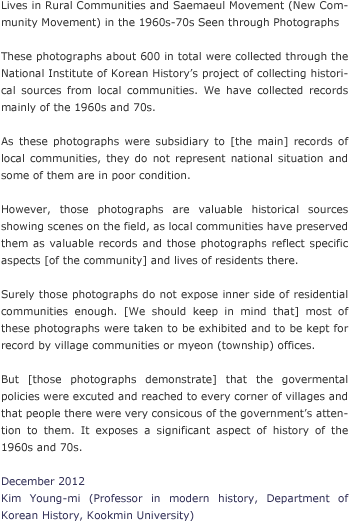There were three main forms of New Village female leadership. The first was female leaders (Bunyeo Jidowon). One woman was chosen from high school graduates for each city or county and was appointed after completing one to two weeks of training. The second type was social campaigners (Saenghwal Jidosa) Starting in the latter half of the 1950s with farmers and also “family instructors (Gajeong Gyodowon)”, the name later changed. These leaders were a major force in the instruction and education of rural housewives to rationalize lifestyles through, for example, clothing, food and housing habits or health and hygiene. Initially one woman was assigned to every two county (Gun), but from 1964 one female leader was assigned to each county. The third type of female leadership was family planning educators. These were women with the equivalent of high school education – nurses and midwives under the age of 55 or nursing auxiliary staff under the age of 40 – who received short-term education at a family planning research center. In practice, however, because many of these women were not licensed, women with high school equivalent education were sent to the townships after receiving about two weeks training. These women provided education on family planning, distributed and mediated contraceptives, provided follow up services, reported statistics, and ran mothers’ groups. (Jang Migyeong, 2008 “Gaebal gukka sigi, Sae Maeul Undong bunyeo jidoja ui jeongcheseong ui jeongchi [The Formulation and change of Identity of Saemaul women Leaders in the development state period: focusing on the successful cases or essays of Saemaul women Leaders]”, in 『Sahoe Gwahak Yeongu [Social Science]』, vol. 16, p. 177).
-
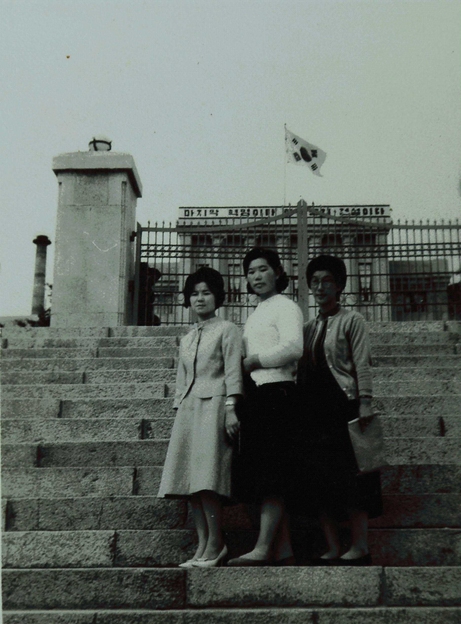 Mid-ranking women at a leadership course, Gangwon-do
Mid-ranking women at a leadership course, Gangwon-do
Personal photograph from Seoksa-dong (town), Chuncheon-si (city), Gangwon-do. 1962. Photograph was taken at the close of a course for female leaders during the time of the Citizens’ Reconstruction Campaign (Jaegeon Gukmin Undong). The distant sign reading “the last revolution” is visible. It appears to signify that the May 16th coup was the completion of the April 19th student revolution, but it holds the wish that any further military coup d’etat would be unacceptable.
-
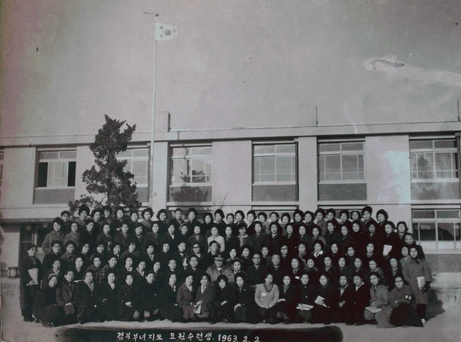 Trainee female leaders in Gyeongsangbuk-do
Trainee female leaders in Gyeongsangbuk-do
Personal photograph of Yi Yeongdon, of Wolhang-myeon (town), Seongju-gun (county), Gyeongsangbuk-do. 1963. It is speculated that these womens’ duties concern family planning. The Bak Jeonghui government’s family planning work started after the coup d’etat in 1961. A family planning information bureau was established within the headquarters of the citizens’ reconstruction campaign (Jaegeon Gukmin Undong) in 1962, and in 1963, 29,000 female citizen campaigners from across the country received special education in family planning . The work of family planning was demanded by the state, but it was effectively carried out in many towns (myeon) where it matched the desire of rural women to reduce the number of household members and to overcome poverty.
-
 President of a mothers’ group in Seongsan-myeon (town)
President of a mothers’ group in Seongsan-myeon (town)
Photograph commemorating all group leaders of mothers’ groups in Seongsan-myeon (town), Goryeong-gun, Gyeongsangbuk-do. Photograph owned by New Village branch office, Goryeong-gun. 1969. They appear to be managers of family planning mothers’ groups. In 1968 the Korean family planning association organized family planning mothers’ groups in every village across the country to administer contraceptives and publicize family planning. Within a short period of time it covered the whole country and cell organizations were formed at the village level, showing that these organizations became an important foundation for the New Village womens’ groups.
-
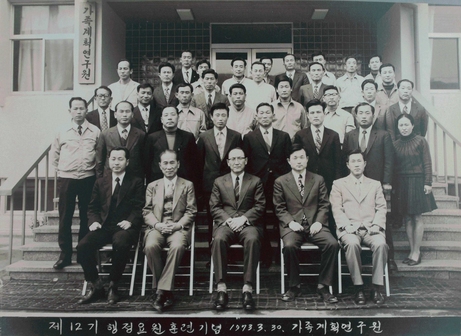 Family planning research center
Family planning research center
Photograph commemorating the 12th training for administrators. Personal photograph from Yanggu-eup, Yanggu-gun, Gangwon-do. 1973. This commemorative photograph look like certain people in each level of administrative organizations had to complete a short course on family planning. In contrast to the mothers’ groups, the administrators responsible for this task were mainly male.
-
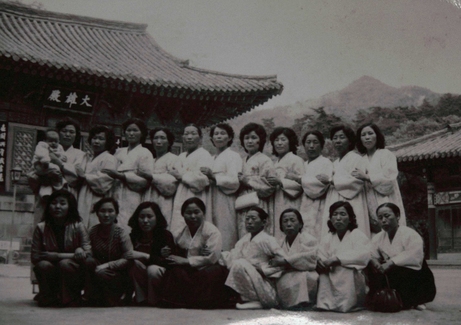 Members of the mothers’ group in Seongsan-myeon (September 28, 1970)
Members of the mothers’ group in Seongsan-myeon (September 28, 1970)
Photograph commemorating managers of the mothers’ groups in Seongsan-myeon, Goryeong-gun. 1970. New Village branch office, Goryeong-gun.
-
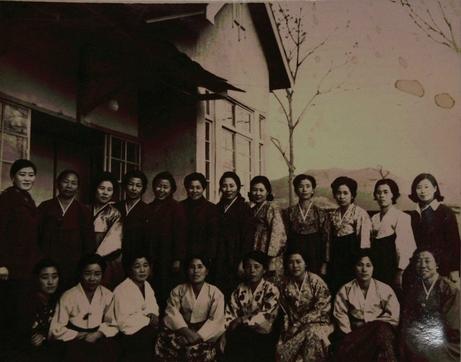 Leaders of each mothers’ group in Goryeong-gun and the wives of the provincial and county teachers
Leaders of each mothers’ group in Goryeong-gun and the wives of the provincial and county teachers
Photograph of managers of the mothers’ groups in Goryeong-gun. Even though these are leaders of female education, it is striking that they are all wearing Korean traditional clothing (Hanbok). Date unknown. Photograph owned by New Village branch office, Goryeong-gun.
-
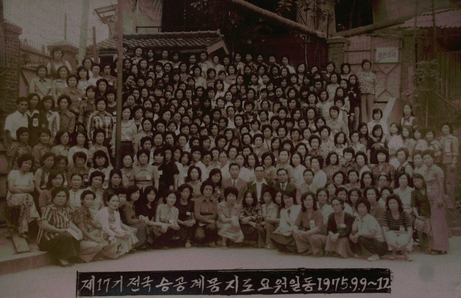 Members of the 17th national leaders for victory over communism
Members of the 17th national leaders for victory over communism
Women were mobilized under the Yusin system not just as actors in the lifestyle improvement and family planning campaigns of the New Village Movement, but also as guardians of the anti-communist system. Photograph owned by New Village branch office, Goryeong-gun. 1975.
-
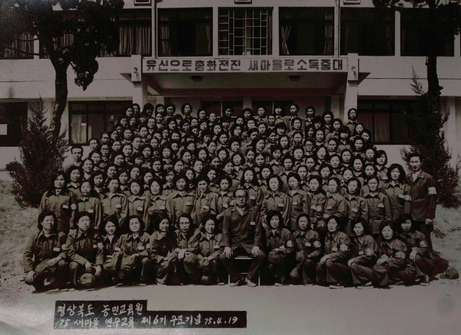 Commemorative photograph from the New Village training institute
Commemorative photograph from the New Village training institute
Commemorative photograph of womens’ leaders participating in training at the Farmers’ Education Institute (Nongmin Gyoyugwon) in Gyeongsangbuk-do. This is the sixth cohort of New Village education training in 1975. At a time when women were rarely allowed to stay out overnight, leaving their families and participating in this kind of public education as individuals was a special experience for the women. The New Village Movement was a movement to renovate people. Through this kind of training, female leaders left behind their tired feelings and internalized the New Village spirit. They brought a strong “desire to live well”. Womens’ active participation in the New Village work through, for example, Intervening to stamp out alcohol and gambling, managing shops, gathering funds, and building village halls, was the foundation of the “aspiration to live well”. Photograph owned by New Village branch office, Goryeong-gun. 1975.
-
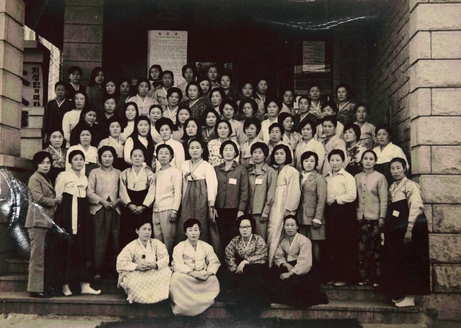 Finishing education at the central meeting for New Village leaders
Finishing education at the central meeting for New Village leaders
Photograph commemorating the completion of education for women leaders. This shows the figures of leaders wearing training uniforms. 1970s. New Village branch office, Goryeong-gun.













